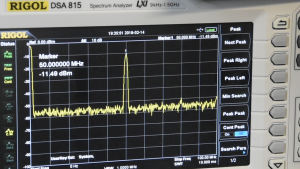Today we have a new blog post for the makers among you. It’s by Rolf-Dieter, the inventor of our bricks, who tested a new brick lately. To illustrate it a little more for you he made a short video that you can check out here: https://youtu.be/7X1rgUosuVs
Below you can see the example code to generate the video at the spectrum analyzer.
We are looking forward to your feedback!
The EMODDDS1 using the AD9851 allows direct generation of a sine signal up to 90 MHz.
Internally, a temperature compensated oscillator generates a stable 30 MHz frequency which is multiplied by the Chip to 180 MHz. This is used to derive all other clocks.
Programming is done via teh SPI bus. We added an I2C controller chip to allow easy expansion to multiple DDS bricks. Programming allows setting of the frequency but also of the phase. To make use of this we provided a feed through pass, when using one of the bricks as master clock generator.
This allows also experiments with phase aligned signals, for example for IQ modulation.
We didn’t use an output filter to allow for using the harmonic frequency capability of the chip. The output is DC coupled to make use of the very low frequency signals less than 1 Hz. An internal D/A converter allows for a great looking sine signal.
Rolf-Dieter K.
Example code to generate the video at the spectrum analyzer:
void loop()
{
int i;
WriteAD9851(1.0,1000000.0); // 1 parameter is phase 0..259 degree then frequency in HZ (also smaller than 1.0).
delay(2000);
WriteAD9851(1.0,10000000.0);
delay(2000);
WriteAD9851(1.0,20000000.0);
delay(2000);
WriteAD9851(1.0,30000000.0);
delay(2000);
WriteAD9851(10.0,50000000.0);
delay(2000);
WriteAD9851(180.0,90000000.0);
delay(2000);
}

 en
en de
de cn
cn fr
fr it
it

